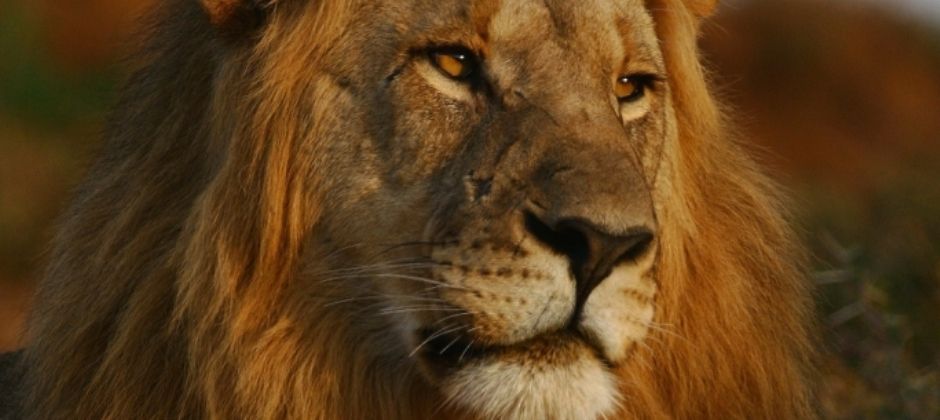
Dee Finney's blog
start date July 20, 2011
Today's date March 25, 2012
page 180
TOPIC: BORN FREE
This is an ongoing program, headed up by some famous people, listed below:
The lions are next to extinction brought on by people moving closer and closer
to them, leaving little room for the animals to be wild and live in their
natural habitat.
See details below:
Here is a radio interview done by Queen's guitarist Brian May who is doing a
fund raiser concert in Cape Town South Africa on march 27, 2012 for the Born
Free organization which he supports.
THE RELEASE OF A CIRCUS LION WHO WAS ABUSED AT THE CIRCUS AND RESCUED.
This lion had to be retrained how to kill its own food and is now released
back into the wild. This photo shows the lion still under medical control,
after which it was put into a pen and watched carefully. When it was
determined that the lion made a full and healthy recovery from its journey, the
fence was taken down the lion made its way onto the lion reserve and fend for
itself.
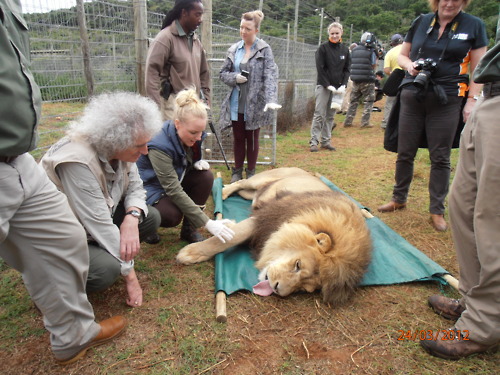
The Born Free Foundation is a conservation and animal rescue
organization in the
United Kingdom. It originated in 1984 as the "Zoo Check Campaign" by actors
Virginia McKenna and her husband
Bill
Travers along with their son
Will Travers and four associates.[
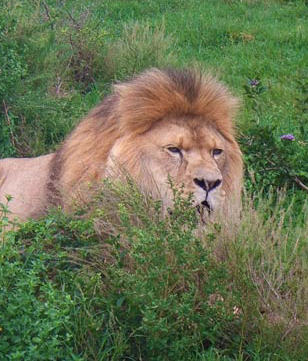
LION IN THE WILD WHERE IT BELONGS
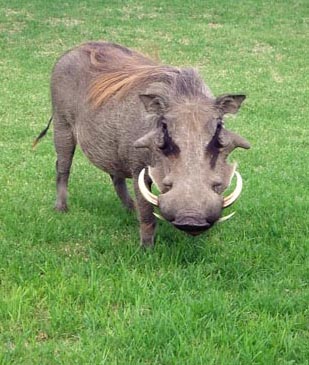
THIS IS A HUMAN FRIENDLY WART HOG
WHICH VISITS THE VISITOR'S CENTER
AT THE REFUGE. IT LIVES OFF THE GARBAGE
PEOPLE THROW OUT.
McKenna and Travers had been greatly affected by the plight of wild animals
after starring together in the 1966 film
Born Free
which told the story of
George and
Joy
Adamson as they returned
Elsa the Lioness to the wilds of
Africa.[2]
They appeared in several more films about animals and produced wildlife and
anti-zoo documentaries for television.
The Born Free Foundation Limited was officially established on 20 July 1998,
and as an umbrella organisation it consists today of the Zoo Check Campaign,
Elefriends Campaign, Wolf Campaign, Dolphin Campaign, Primate Campaign, Big Cat
Campaign, and the Bear Campaign. It is a charity registered in England & Wales.[3]
The Born Free Foundation undertakes animal welfare, conservation and public
awareness campaigns to prevent animal abuse and to keep wildlife in its natural
habitat. Its logo is a lion, which its website states is a likeness of Elsa.
The foundation, which is part of the International Tiger Coalition (ITC),[4]
has two big cat sanctuaries in
South
Africa at the
Shamwari Game Reserve in the Eastern Cape. Several lions and leopards have
been rescued from appalling conditions all over the world and returned to their
native home: Africa. The two sanctuaries also serve as education centres
for school children from all over. Up to 500 scholars visit the centres each
month.
Wild and Live
On Saturday 14 November 2009 Bryan Adams, Martin Clunes, Gabriella Cilmi,
Mutya Buena, Joanna Lumley and many other celebrity supporters gathered at the
Royal Albert Hall to help save 25,000 wild animals and commemorate the Born Free
Foundation’s 25th Anniversary year.[5]
References
External links
BORN FREE USA
http://www.bornfreeusa.org/
BORN FREE UK
http://www.bornfree.org.uk/
In 1960, there were 400,000 lions living in the wild. Today, there are just
20,000.
"That represents a 90 to 95 percent decline," says National Geographic
explorer-in-residence Dereck Joubert. "Unless we start talking about this, these
lions will be extinct within the next 10 or 15 years."
Joubert and his wife, Beverly, have lived among populations of big wild cats
for decades. Based in Botswana, the filmmakers and conservationists have spent
much of their career documenting Africa's animal population for National
Geographic. In their latest documentary project, The Last Lions, the
Jouberts follow the dwindling lion population living in Botswana's Okavango
Delta as they battle their prey — the buffalo — as well as rival prides.
"Marauding lions [come] in from the outside into their territory and fight
with them," says Dereck Joubert. "These territorial battles are dramatic and
often end up in death one way or another."
But obtaining dramatic footage of lions battling each other in the murky,
swamplike Okavango Delta is not easy, even for seasoned documentarians like the
Jouberts. They followed lions across river systems, pushing their car into
chest-height water while driving — and they often had a front-row seat to heated
attacks.
"Generally, we're situated about 20 to 30 paces from the action," says Dereck
Joubert. "It's fairly chaotic. You never know where it's going to come from,
where it's going to end up. Often, the action breaks closer to you than the
ideal."
If the action breaks closer, the Jouberts are able to remain calm and in
their vehicle — which doesn't have doors, a windshield or a roof — because, says
Beverly Joubert, experience has given them insight into how the aggressive cats
are likely to react.
"We believe that our knowledge over 28 years has prepared us to keep safe,
and it's kept us being good filmmakers, without ever challenging the animals,
without wanting them to give us an incredible aggressive look," she says. "We
feel like the luxury of time will eventually give us that look, but we never,
ever want to threaten an animal.
FROM
http://www.npr.org/2011/03/02/133999157/without-intervention-lions-heading-for-extinction
NOTE FROM DEE: In a recent documentary we watched, they stated that 37
people hadr been killed by lions recently.
you might find it strange that no Christians are killed by lions, only Muslims,
but that is because of wehre and how they live and thheir food diet.
Christians eat pigs, Muslims do not. Therein is the begining of the
problem, because the Christians pen up the wild pigs they catch to eat, and the
Musli9ms do not. In Muslim territory which is farm land, the wild pigs run
lolose and that is what lions go after, but when they come into contact with a
farmer, whether male, female or child, the young lions find it easier to
catch a human than a wild pig.
Apparently the Muslim farmers do not have weapons to defind themselves except
maybe a stick or the hoe they are tending their gardens with. The best
they can do ois to hire men from outside the community to come in and sohot the
marauuding lions, which they cnsider rogue killers.
Most of those lions are young, without prides. Older lions who live in
a pride lay around in the sun, snoozing, while their female companions do the
killing of other animals in packs, usually choosing antelope or other type ofo
animals that don't run as fast as they do. However, the young lions
born to those femals are kicked out of the pride when they are old ennough and
roam around and have to feedr themselves, so they pickk on the sick, sloow, and
human people who can't run from them.
On to pof that, the Muslim farmers are encroaching closer and closer to the
animal reserve, which of course is not fenced, and the farm fields are not
fenced either.
At one point in the documentary, in the middle of the night, a young lion
jumped on top of a thatched hut wehre a man, his wives and cihldren were
sleeping. Hearing the noise on his roof, the farmer turned on a light,
thinkikng that the lion would run off from the kight, but this smart lion used
the light to dig his way inside the hut and killed the man.
Once a lion kills a human, it must be destroyed as it knows humans are easy
prey. It can't be restored to the wild after that.
Lions cnanot all be put into zoos either. They were BORN FREE and
should be kept that way - its the humans who are encroaching on their territory.
Humans, therfore, need too live farther away from the reserve and perhaps
fence themselves in better, but eliminating all animals is not the answer t
othis dillemma.
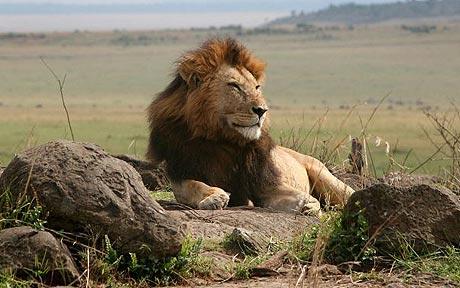
Lions face extinction in Kenya within 20 years
Lions may become extinct in Kenya within the next 20 years unless urgent
action is taken to save them, conservationists warned.
By Mike Pflanz in Nairobi
1:01AM BST 18 Aug 2009
Kenya is annually losing an average of 100 of its 2,000 lions due to
growing human settlements, increasing farming, climate change and
disease, according to the Kenya Wildlife Service.
"Lions have a special place in Kenyans' livelihood and conservation
efforts," said Paul Udoto, a spokesman for the organisation.
"Other than being the symbol for national strength, they are among
the Big Five, a major attraction for visitors to Kenya."
There were 2,749 lions in Kenya in 2002 and their population dropped
to 2,280 by 2004 and to roughly 2,000 today, according to KWS figures.
"The trend of lion population decline is disturbing and every effort
needs to be made to ensure that Kenya either stabilises its population
at the current population of 2,000 lions or increases the numbers to an
ecologically acceptable level," said Mr Udoto.
"Quick and decisive actions need to be taken to create public
awareness as well as formulation of national guidelines on lion
conservation and management in the long term."
FROM:
http://www.telegraph.co.uk/news/worldnews/africaandindianocean/kenya/6045282/Lions-face-extinction-in-Kenya-within-20-years.html
| Red List Category & Criteria: |
Vulnerable A2abcd
ver 3.1 |
| Year Published: |
2008 |
| Assessor/s: |
Bauer, H., Nowell, K. & Packer, C. |
| Reviewer/s: |
Nowell, K., Breitenmoser-Wursten, C., Breitenmoser, U. (Cat
Red List Authority) & Hoffmann, M. (Global Mammal Assessment
Team) |
Justification:
A species population reduction of approximately 30% is
suspected over the past two decades (= approximately three Lion
generations). The causes of this reduction (primarily
indiscriminate killing in defense of life and livestock, coupled
with prey base depletion: Bauer 2008), are unlikely to have
ceased. This suspected reduction is based on direct observation;
appropriate indices of abundance; a decline in area of
occupation, extent of occupation and habitat quality; and actual
and potential levels of exploitation.
Estimating the size of the African Lion population is an
ambitious exercise involving many uncertainties. The three main
efforts (Ferreras and Cousins 1996; Chardonnet 2002; Bauer and
Van Der Merwe 2004) all use different methods. The African Lion
Working Group compiled individual population estimates primarily
from protected areas (23,000 Lions: Bauer and Van Der Merwe
2004). In 1980, Ferreras and Cousins (1996) predicted 18,600
Lions to occur in protected areas. This was probably an
underestimate as not all protected areas inhabited by Lions at
that time were included. Still, the comparison suggests that the
number of Lions in African protected areas has remained stable
or possibly increased over time. But Ferreras and Cousins (1996)
predicted that most Lions in 1980 were found outside protected
areas. Chardonnet (2002) finds that unprotected areas still
comprise a significant portion (half) of the Lion's current
African range. Comparison of Ferreras and Cousin's (1996)
prediction of 75,800 Lions in 1980 (roughly three Lion
generations ago) to Chardonnet's (2002) estimate of 39,000 Lions
yields a suspected decline of 48.5%. This calculation suggests a
substantial decline in Lions outside protected areas over the
past two decades. Ferreras and Cousins (1996) may have
over-estimated the African Lion population in 1980, as their
number was derived from a model rather than actual Lion counts,
and so it is possible that the rate of decline of the African
Lion population may be lower. A group exercise led by WCS and
the IUCN SSC Cat Specialist Group estimated that 42% of major
Lion populations were declining (Bauer 2008). The rate of
decline is most unlikely to have been as high as 90%, as
reported in a series of news reports in 2003 (Kirby 2003, Frank
and Parker 2003).
In Sub-Saharan Africa, the Lion conservation community works in
the context of four regions: West, Central, East and Southern.
The Lion population is classified as regionally Endangered in
West Africa (Bauer and Nowell 2004). It is isolated
from Lion populations of Central Africa, with little or no exchange of breeding
individuals (Chardonnet 2002, Bauer and Van Der Merwe 2004). The
number of mature individuals in West Africa
is estimated by two separate recent surveys at 850 (Bauer and
Van Der Merwe 2004) and 1,163 (Chardonnet 2002). Both estimates
are well below the Endangered criterion level of 2,500. Lions in
West Africa are grouped into three isolated
subpopulations by Chardonnet (2002) and approximately seven by
the African Lion Working Group (Bauer and Van Der Merwe 2004).
Chardonnet?s (2002) three subpopulations consist of 18 different
individual populations, between which there may be some
interchange of individuals, although this is unknown. There is
disagreement over the size of the largest individual population
in West Africa: the African Lion Working Group (Bauer and Van
Der Merwe 2004) estimates 100 Lions in Burkina Faso?s Arly-Singou ecosystem,
while Chardonnet (2002)
estimates 404 for the same area (mean 250). |
| History: |
| 2004 |
– |
Vulnerable |
| 2002 |
– |
Vulnerable |
| 1996 |
– |
Vulnerable |
|
Geographic Range
[top]
| Range Description: |
Lions are found in most countries in sub-Saharan Africa. In
2005-2006 the Wildlife Conservation Society and the IUCN SSC Cat
Specialist Group undertook an extensive collaborative exercise
to map and assess current lion range in sub-Saharan Africa (IUCN
2006a,b; Bauer 2008). Extent of occurrence is estimated at over
4.5 million km², 22% of historical range. Most lion range is in
eastern and southern Africa (77%). Current Lion status is still
unknown over large parts of Africa, 7.6 million km².
The Lion formerly ranged from northern Africa through southwest
Asia (where it disappeared from most countries within the last
150 years), west into Europe, where it apparently became extinct
almost 2,000 years ago, and east into India (Nowell and Jackson
1996, Sunquist and Sunquist 2002). Today, the only remainder of
this once widespread population is a single isolated population
of the Asiatic Lion P. leo persica in the 1,400 km² Gir
Forest National Park and Wildlife Sanctuary. Lions are extinct
in North Africa, having perhaps survived in the High Atlas
Mountains up to the 1940s (Nowell and Jackson 1996, West and
Packer in press).
The map (provided by the Wildlife Conservation Society) shows
Lion range as derived from mapping workshops associated with two
regional Lion conservationo strategies. In West and
Central Africa, known and probable range are shown
(IUCN 2006a). In Eastern and Southern
Africa, known, occasional and possible range are
shown (IUCN 2006b). Both strategies are available online from
the IUCN SSC Cat Specialist Group website
http://www.catsg.org/catsgportal/bulletin-board/20_bulletin-board/home/index_en.htm
|
| Countries: |
Native:
Angola; Benin; Botswana; Burkina Faso; Cameroon; Central
African Republic; Chad; Congo, The Democratic Republic
of the; Côte d'Ivoire; Ethiopia; Ghana; Guinea;
Guinea-Bissau; India; Kenya; Malawi; Mali; Mozambique;
Namibia; Niger; Nigeria; Rwanda; Senegal; Somalia; South
Africa; Sudan; Swaziland; Tanzania, United Republic of;
Uganda; Zambia; Zimbabwe
Regionally extinct:
Afghanistan; Algeria; Djibouti; Egypt; Eritrea; Gambia;
Iran, Islamic Republic of; Iraq; Israel; Jordan; Kuwait;
Lebanon; Lesotho; Libyan Arab Jamahiriya; Mauritania;
Morocco; Pakistan; Saudi Arabia; Sierra Leone; Syrian
Arab Republic; Tunisia; Turkey; Western Sahara
Presence uncertain:
Burundi; Congo; Togo
|
| Range Map: |
Click here to open the map viewer and explore range. |
Population
[top]
| Population: |
There have been few efforts in the past to estimate the
number of Lions in
Africa. Myers (1975) wrote, "Since 1950, their
[Lion] numbers may well have been cut in half, perhaps to as low
as
200,000 in
all or even less". Later, Myers (1986) wrote, "In light of
evidence from all the main countries of its range, the Lion has
been undergoing decline in both range and numbers, often an
accelerating decline, during the past two decades". In the early
1990s, IUCN SSC Cat Specialist Group members made educated
"guesstimates" of 30,000 to 100,000 for the African Lion
population (Nowell and Jackson 1996).
The most quantitative historical estimate of the African Lion
population in the recent past was made by Ferreras and Cousins
(1996), who developed a GIS-based model to predict African Lion
range and numbers, calibrated by surveying experts about the
factors affecting Lion populations. First they correlated
vegetation (Leaf Area Index) with Lion densities, using known
values from 37 studies in 19 African protected areas, and mapped
potential Lion range. Then the reduction effect of human
activities on Lion range and numbers were estimated. Lion
experts were surveyed in order to develop and rank a set of
factors which would lead to lower Lion densities as well as Lion
absence. These included agriculture, human population density,
cattle grazing, and distance from a protected area, and were
derived from GIS databases of varying age. For example, in areas
identified as main cattle grazing areas Lion density was reduced
by 90%, and in areas identified as having widespread
agricultural cultivation or high human population density (> 2.5
people/km²) Lions were considered absent. Lion density was
reduced by 50% in areas with low human population density (1-2.5
people/km²). Because of the age of their data sources on extent
of agriculture and pastoralism, Ferreras and Cousins (1996)
selected 1980 as the base year for their predicted African Lion
population of 75,800. They emphasized the need for
ground-truthing their estimate by censusing Lions, particularly
outside protected areas.
Two recent surveys have provided current estimates of the
African Lion population, with some ground-truthing. The African
Lion Working Group, a network of specialists affiliated with the
IUCN SSC Cat Specialist Group, conducted a mail survey and
compiled estimates of 100 known African Lion populations. Not
included were populations of known existence, but unknown or
unestimated size. The ALWG African Lion population estimate is
23,000, with a range of 16,500-30,000 (Bauer and Van Der Merwe
2004). The second survey was carried out by Philippe Chardonnet
and sponsored by the International Foundation for the
Conservation of Wildlife and Conservation Force (Chardonnet
2002). He also compiled estimates for 144 individual African
Lion populations, grouped into 36 largely isolated
subpopulations. His methodology included extrapolation of
estimates of known populations into areas where Lion status was
unknown, and his total figure is not surprisingly larger: 39,000
Lions in Africa, with a range of 29,000-47,000.
Approximately 30% of the individual population estimates
compiled by the African Lion Working Group were based on
scientific surveys. Techniques for these surveys included total
count based on individually identified body features, sampling
by use of calling stations playing recordings of hyaena and/or
Lion prey, and mark-recapture methods including radio telemetry,
photo databases, and spoor counts (Bauer and Van Der Merwe
2004). Seventy percent of their population figures were derived
from expert opinion or guesstimate. In the other survey, 63% of
Chardonnet's (2002) individual population estimates were based
on expert opinions or guesstimates. Twelve percent of
Chardonnet's (2002) estimates were based on scientific surveys,
and a further 25% were derived from extrapolation of variables
from nearby populations and catch-per-unit effort-estimates
based on Lion trophy hunting.
Estimating the size of the African Lion population is an
ambitious exercise involving many uncertainties. The three main
efforts (Ferreras and Cousins 1996; Chardonnet 2002; Bauer and
Van Der Merwe 2004) all use different methods. The African Lion
Working Group compiled individual population estimates primarily
from protected areas (23,000 Lions: Bauer and Van Der Merwe
2004). In 1980, Ferreras and Cousins (1996) predicted 18,600
Lions to occur in protected areas. This was probably an
underestimate as not all protected areas inhabited by Lions at
that time were included. Still, the comparison suggests that the
number of Lions in African protected areas has remained stable
or possibly increased over time. But Ferreras and Cousins (1996)
predicted that most Lions in 1980 were found outside protected
areas. Chardonnet (2002) finds that unprotected areas still
comprise a significant portion (half) of the Lion's current
African range. Comparison of Ferreras and Cousin's (1996)
prediction of 75,800 Lions in 1980 (roughly three Lion
generations ago) to Chardonnet's (2002) estimate of 39,000 Lions
yields a suspected decline of 48.5%. This calculation suggests a
substantial decline in Lions outside protected areas over the
past two decades. Ferreras and Cousins (1996) may have
over-estimated the African Lion population in 1980, as their
number was derived from a model rather than actual Lion counts,
and so it is possible that the rate of decline of the African
Lion population may be lower. A group exercise led by WCS and
the IUCN SSC Cat Specialist Group estimated that 42% of major
Lion populations were declining (Bauer 2008). The rate of
decline is most unlikely to have been as high as 90%, as
reported in a series of news reports in 2003 (Kirby 2003, Frank
and Parker 2003).
Genetic population models indicate that large populations
(50-100 Lion prides) are necessary to conserve genetic diversity
and avoid inbreeding, which increases significantly when
populations fall below 10 prides. Male dispersal is also an
important factor in conserving genetic variation (Bjorklund
2003). These conditions are met in few wild Lion populations,
although there are at least 17 Lion "strongholds" >50,000 km² in
extent (Bauer 2008).
Outside sub-Saharan Africa, the Asiatic Lion P. leo persica
occurs as an isolated single wild population in
India's Gir Forest. The Gir Lion population had been
reduced to a very low number in the early years of the 20th
century, possibly fewer than
20. In 1936, 234 Lions were estimated,
falling to approximately 100 iin the 1970s, and estimates in the
1980s and 1990s around 200 adults (Nowell and Jackson 1996). In
2005, the population was estimated at 359, +/- 10, including
cubs, based on, according to the Chief Minister of Forests for
Gujarat state, a total count of Lions by direct
sighting in a block-system methodology. This is an increase from
327 reported in 2001 (Anon. 2006). The Wildlife Protection
Society of India reported 34 Lion deaths in 2007, due to
poaching, electrocution, falling into open wells, and death by
motor vehicle and unknown causes. Single populations are
vulnerable to extinction from catastrophic events, and it has
long been recommended by scientists to establish a second wild
population in Madhya Pradesh's Kuno Wildlife Sanctuary, but this
has not yet been done (Jackson 2008). The Asiatic Lion shows
reduced genetic variation due to small population size (O'Brien
et al. 1987). It is feared that the size of the
population is larger than the estimated carrying capacity of the
habitat and prey base (Nowell and Jackson 1996).
For further information about this species, see
15951.pdf.
|
| Population Trend: |
 Decreasing Decreasing
|
Habitat and Ecology
[top]
| Habitat and Ecology: |
The Lion has a broad habitat tolerance, absent only from
tropical rainforest and the interior of the
Sahara desert (Nowell and Jackson 1996). There are
records of Lion to elevations of more than
4,000 m
in the Bale
Mountains and on
Kilimanjaro (West and Packer in press). Although Lions drink
regularly when water is available, they are capable of obtaining
their moisture requirements from prey and even plants (such as
the tsama melon in the Kalahari desert), and thus can survive in very arid
environments. Medium- to large-sized ungulates (including
antelopes, zebra and wildebeest) are the bulk of their prey, but
Lions will take almost any animal, from rodents to a rhino. They
also scavenge, displacing other predators (such as the Spotted
Hyaena) from their kills.
Lions are the most social of the cats, with related females
remaining together in prides, and related and unrelated males
forming coalitions competing for tenure over prides. Average
pride size (including males and females) is four to six adults;
prides generally break into smaller groups when hunting. Lions
tend to live at higher densities than most other felids, but
with a wide variation from 1.5 adults per 100 km² in southern
African semi-desert to 55/100 km² in parts of the Serengeti
(Sunquist and Sunquist 2002). Pride ranges can vary widely even
in the same region: e.g., from 266-4,532 km² in the Kgalagadi
Transfrontier Park of South Africa (Funston 2001), and 20,500
km² in the Serengeti (West and Packer in press).
In
India, the habitat of the Asiatic
Lion is dry deciduous forest. The Gir National Park
and Wildlife Sanctuary is surrounded by cultivated areas and
inhabited by the pastoralist Maldharis and their livestock.
Domestic cattle have historically been a major part of the
Asiatic Lion's diet, although the most common prey is the chital
deer. Mean pride size, measured by the number of adult females,
tends to be smaller than for African Lions: most Gir prides
contain an average of two adult females (Nowell and Jackson
1996).
|
| Systems: |
Terrestrial |
| Major Threat(s): |
The main threats to Lions are indiscriminate killing
(primarily as a result of retaliatory or pre-emptive killing to
protect life and livestock) and prey base depletion. Habitat
loss and conversion has led to a number of populations becoming
small and isolated (Bauer 2008).
The economic impact of stock raiding can be significant:
Patterson et al. (2004) estimated that each Lion cost
ranchers in Kenya living alongside Tsavo East
National Park US$290 per year in livestock losses. Likewise,
annual losses of cattle to Lions in areas adjacent to Waza National Park
in Cameroon comprised only about 3.1% of
all livestock losses, but were estimated to represent more than
22% of financial losses amounting to about US$370 per owner
(Bauer 2003). Consequently, Lions are persecuted intensely in
livestock areas across Africa; their scavenging behaviour makes them particularly
vulnerable to poisoned carcasses put out to eliminate predators.
Little actual information exists on the number of Lions killed
as problem animals by local people, even though this is
considered the primary threat to their survival outside
protected areas. Implementation of appropriate livestock
management measures, coupled with problem animal control
measures and mechanisms for compensating livestock losses, are
some of the primary responses to resolving human-Lion conflict
(Frank et al. 2006).
Trophy hunting is carried out in a number of sub-Saharan African
countries and is considered an important management tool for
providing financial resource for Lion conservation for both
governments and local communities. However, there is concern
that current management regimes can lead to unsustainable
offtakes (Packer et al. 2006).
Disease has also been a threat to Lion populations (Ray et
al. 2005).
In parts of southeastern Tanzania there have been alarmingly
high incidences of people killed by Lions, with up to 400 human
Lion-related fatalities recorded from 1997-2007 (Ikanda 2007).
|
Conservation Actions
[top]
| Conservation Actions: |
P. leo is included in CITES Appendix II; the
Endangered Asiatic Lion subspecies P. leo persica is
included in CITES Appendix I.
In Africa, Lions are present in a number of large and
well-managed protected areas, and remain one of the most popular
animals on the must-see lists of tourists and visitors to
Africa. Most range states in East and
Southern Africa have an infrastructure which
supports wildlife tourism, and in this way Lions generate
significant cash revenue for park management and local
communities and provide a strong incentive for wildland
conservation.
Regional conservation strategies have been developed for Lions
in west and central Africa (IUCN 2006a) and eastern and southern
Africa (IUCN 2006b). The West and Central
African Lion Conservation Strategy focuses on three primary
objectives to address threats that directly impact Lions: to
reduce Lion-human conflict, and to conserve and increase Lion
habitat and wild prey base. The objectives of the Eastern and
Southern African Lion Conservation Strategy are articulated
around the root issues in Lion conservation, including policy
and land use, socio-economics, trade, and conservation politics.
For example, the policy and land use objective is "to develop
and implement harmonious and comprehensive legal and
institutional frameworks that provide for the expansion of
wildife-integrated land use, Lion conservation and associated
socio-economic benefits in current and potential Lion range."
The trade objective is "to prevent illegal trade in Lions and
Lion products while promoting and safeguarding sustainable legal
trade." Both regional strategies share common priorities of
conserving and restoring Lion populations, improving management
capacity, and increasing the flow of benefits to communities
living with Lions. These strategies should be used by
governments to guide national Lion action plans, policies and
programs, and by the conservation community to guide their
project development. By setting out common priorities to guide
action on both national, community and landscape levels, the
regional conservation strategies have the potential for broad
and significant improvement of Lion status and management
(Nowell et al. 2006).
For the Asiatic Lion, resolving human Lion-conflict is a high
priority, as well as establishing a second wild population
(Jackson 2008).
|
THIS BLOG
CONTINUES ON PAGE 181
2011
2012
INDEX
JAN, FEB, MAR, APR 2012
MAY, JUNE, JULY, AUG 2012
SEPT, OCT, NOV, DEC. 2012
JAN, FEB, MAR, APR. 2013





